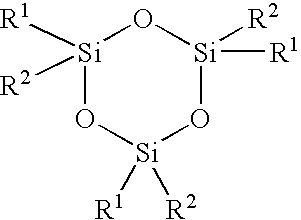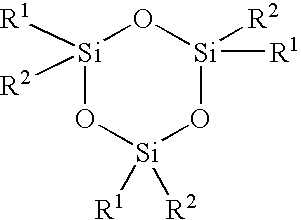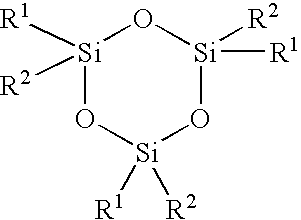Process for making siloxane oligomer
a technology of siloxane oligomers and siloxane oligomers, which is applied in the field of making siloxane oligomers, can solve the problems of difficult preparation of mono-si—h functional or telechelic si—h functional siloxane oligomers or siloxane oligomers with narrow polydispersity, and the process may be difficult to conduct at an industrial scal
- Summary
- Abstract
- Description
- Claims
- Application Information
AI Technical Summary
Problems solved by technology
Method used
Image
Examples
example 1
Reaction of hexamethylcyclotrisiloxane (D3) with PhMe2SiH
[0028] This reaction is carried out in accordance with the Experimental Procedure described above. 1.60 g of D3 is sublimed on a high vacuum line into the reactor to which 2.93 g of PhMe2SiH reagent. 0.0517 of toluene solution containing 1.01×10−4 mol of B(C6F5)3 catalyst such that [B(C6F5)3] is 1.87×10−2 molkg−1 solution is introduced by means of a precision Hamilton syringe. Temperature of the reaction is 24.2° C. Results are shown in Table 1.
TABLE 1Results of Example 1D31st TelomerTimeD3%PhMe2SiHPhMe2SiHPhMe2Si(OSi)3H(s)Rel IntconvRel Int% convRel Int103.2106.92002203.1236.3680.0643902.7813.56.15110.14042102.3626.56.1211.50.3853601.83435.7217.50.6466401.18635.11260.92712000.451864.29380.84824000.18094.53.5648.50.62950000.04598.63.4949.00.3971022700minor>99.53.5349.50.3331129500minor>99.53.14550.315
example 2
Reaction of hexamethylcyclotrisiloxane (D3) with PhMe2SiH
[0029] This reaction is carried out in accordance with the Experimental Procedure described above. 1.19 g of D3 is sublimed on a high vacuum line into the reactor to which 0.796 g of PhMe2SiH reagent and 2.42×10−2 molkg−1 of B(C6F5)3 catalyst are added. Temperature of the reaction is 25° C. The first Telomer is PhMe2Si(OSi)3H and the second Telomer is PhMe2Si(OSi)6H. The reaction is monitored by GC and the results are shown in Table 2.
TABLE 2Results of Example 2D31st2ndTimeD3%PhMe2SiHPhMe2SiHTelomerTelomer(s)Rel IntconvRel Int% convRel IntRel Int103.0802.530002292.867.12.1315.90.041031102.6713.42.02200.111042002.4420.61.9622.40.204053202.3324.41.7232.10.345065401.9835.81.5339.50.501minor712001.2459.71.0359.40.6610.092824000.56581.70.65374.30.5400.149936000.23592.40.52279.40.3120.1641067000.04698.50.49880.30.0990.07811108000.04598.50.49680.40.1000.07912225000.03299.00.39584.40.0590.047
example 3
Reaction of hexamethylcyclotrisiloxane (D3) with 1,1,3,3-tetramethyldisiloxane (HMMH)
[0030] The reaction of D3 with HMMH is performed in concentrated toluene solution using equimolar ratio of substrates and using an excess of D3. Amounts of the specific ingredients are set forth in Table 3 for Examples 3a and 3b. The reaction is carried out in room temperature under nitrogen in a 10 ml thermostated reactor equipped with magnetic stirrer and a three way glass stopcock connected to a nitrogen gas circulating system fitted with bubbler. An amount of D3 is sublimed on a high vacuum line into the reactor which is then filled with nitrogen gas and an amount of HMMH, of ABCR (97%) purified by keeping over fresh CaH2, dodecane and prepurified toluene are placed in the reactor by means of Hamilton syringes under positive pressure of nitrogen. An amount of the stock solution of the catalyst, B(C6F5)3, in toluene is introduced by a precision Hamilton syringe. The time of the catalyst introduc...
PUM
| Property | Measurement | Unit |
|---|---|---|
| Fraction | aaaaa | aaaaa |
| Fraction | aaaaa | aaaaa |
| Fraction | aaaaa | aaaaa |
Abstract
Description
Claims
Application Information
 Login to View More
Login to View More - R&D
- Intellectual Property
- Life Sciences
- Materials
- Tech Scout
- Unparalleled Data Quality
- Higher Quality Content
- 60% Fewer Hallucinations
Browse by: Latest US Patents, China's latest patents, Technical Efficacy Thesaurus, Application Domain, Technology Topic, Popular Technical Reports.
© 2025 PatSnap. All rights reserved.Legal|Privacy policy|Modern Slavery Act Transparency Statement|Sitemap|About US| Contact US: help@patsnap.com



